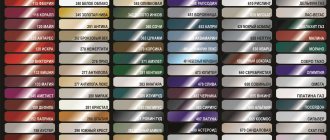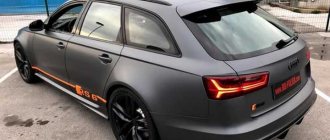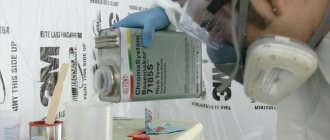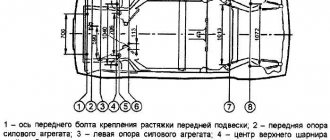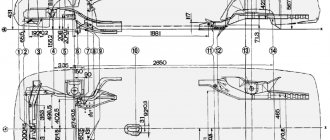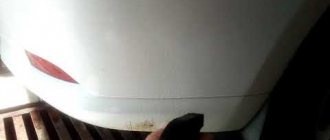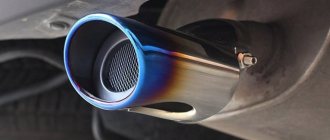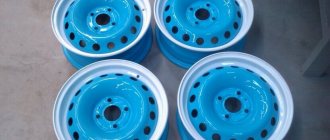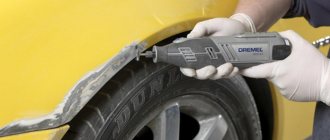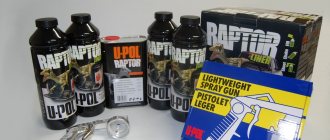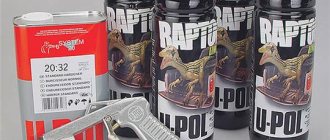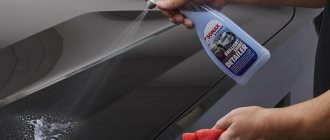Modern motorists are sensitive not only to the technical serviceability of the vehicle, but also to its appearance. Therefore, the exact selection of paint coating when partially replacing body parts or in the presence of chips, scratches and damage to the body is a pressing topic. When faced with the need to repair the body coating, the car owner can avoid gross mistakes and unnecessary costs if he takes into account the nuances and chooses the right method for selecting the color.
Individual approach
A mediocre colorist doesn't go into detail. Given a color sample (for example, a gas filler flap), he uses the existing color matching program to obtain the most suitable shade. In addition to the main paint code, systems offer several varieties of it - the tone is slightly darker or lighter. These are so-called service formulas, which take into account the effect of different barrels at the plant. In reality, this approach is ineffective.
Types of car enamels, their properties and features
First, you need to understand what the paintwork of your car is. There are several main types of coverage; Coatings applied in 1-3 layers are common. The paintwork has more than just a decorative function. Modern car enamels protect the car body from the destructive effects of the environment and prevent corrosion processes.
Automotive enamels
When repairing car coatings, acrylic-polyurethane enamels are most often used, providing excellent appearance and protective functions. Such enamels are applied in one or two layers.
When covering a car, in one layer , providing body color, shine and protection of the body from the negative influence of external factors. Repairing a single-layer coating is economical in cost, especially since it can be done independently. But still, the need to repair single-layer coatings arises more often in comparison with two- and three-layer coatings.
two-layer coating is made by applying the first layer of auto enamel and the second layer of varnish. Two-layer coatings are mainly used for metallic and pearlescent coatings.
The basis of the color and varnish coating is two-component acrylic enamel, so the methods of applying the coloring composition and protective varnish do not differ significantly. The paint contains pigment and/or reflective components, while the varnish is completely transparent.
Such coloring methods are also applicable to ordinary universal enamels.
A three-layer coating is applied as follows: a layer of base paint is applied over the ground, which is covered with an effective enamel containing reflective particles, and the final layer is a protective varnish. A special feature of this coating is the effect of illuminated deep shine. When repairing such a coating, the thickness of the layer of mother-of-pearl applied by the master and the number of layers greatly influence the result. Therefore, paint for repairing a three-layer paintwork is prepared only by a professional colorist according to a strictly verified recipe.
Workplace
Standard tools for a colorist: a room in neutral colors, a spectrophotometer, a set of lamps, booths for test spraying and studying the sample.
A spectrophotometer is a good addition to a color matching program; it helps to determine the shade formula as accurately as possible.
It is critical to use lamps that mimic natural outdoor lighting. Many colors play different colors indoors and outdoors.
The study booth is a “box” with five neutral-colored walls and several types of lamps. It is needed to examine a gas tank flap or other sample from all sides and under different lighting conditions and identify all the obvious and hidden shades.
The spray test booth is needed to discuss the nuances of paint application with the painter.
Select color by VIN code
There are paint numbers for cars, these are the so-called VIN codes, presented in the form of a sticker, which is located on the inside of the hood. Using the number, you can choose the color yourself if you need to repaint the entire car or a separate part. It is worth considering here that during operation the paintwork may fade, which will significantly change its shade.
The selection of paint is carried out using a computer and a special program. To do this, you just need to enter the code in the required line on the manufacturer’s website. The result is obtained instantly. Auto stores also offer specialized palettes with which you can choose paint color.
Some manufacturers apply a type of tint directly to the aerosol can. The color matches it perfectly. By code, number and brand, you can quickly select the material for painting your car.
Often the selection of enamel is carried out using a gas tank cap. You just need to attach it to the catalog and find a color match.
On the video: where to look for the VIN code or body number of a car.
Experimental
For a high-quality color selection, a removed gas tank flap is usually sufficient. The colorist can freely view it from different angles in all kinds of lighting. By the way, the example of the hatch clearly shows the current trend: saving on paint. An uneven and thin layer, in some places the soil even glows - even premium brands have begun to sin with this. Ideally, this economical application should be repeated by the painter so that the painted part stands out less. And it is very important to use the appropriate primer.
If the car has already been painted, it is advisable to select the color throughout the body, and not separately for the hatch. After all, there is always a certain difference in body parts with factory paint and repair paint. Therefore, it is important to choose a certain middle tone so as not to aggravate the differences in shades and hide color transitions.
What to consider?
There are several ways to select paint for a car. They differ in price and complexity of implementation. Some owners prefer to choose the color by eye. Of course, it is better to solve this problem using a VIN code or special equipment. There is also a special program that will allow you to choose paint for your car online.
In any case, before painting you need to consider some nuances:
- The result of coloring largely depends on the artist who will carry it out. The equipment and materials used are also important. It is worth noting that the use of a color substance in a spray can reduces the quality of the paintwork renewal. This applies to mixed paints.
- The color can be assessed only after the enamel has completely dried. Therefore, there is no need to apply the substance to the entire machine or part. Start by choosing an approximate color and then calibrate it. So, blue can have several shades.
- If a spectrophotometer was used during the selection process, then painting should still be carried out carefully. It is best to start by processing the old part. This will make it possible to evaluate accuracy. After this, you can begin to completely paint the car.
Before choosing paint for your car, you need to take all these features into account. This will ensure the quality of the final result. This also applies to the type of paint, for example, metallic auto enamel has some application features.
Where to look for paint information
On the vehicle information plate. Depending on the brand, it can be located in different places, but most often it is placed under the hood, on the side frame (on the passenger or driver's side). On some brands it is located in the trunk.
It is also worth remembering that the plate indicates the factory color of the car. Thus, if the car's paint has been changed previously, the plate will not provide the necessary information.
What is the difficulty of choosing paint for a car?
It should be noted that buying car paint in a can is not always about car repair.
We should not forget that many people prefer to tune their vehicle themselves, painting it completely or only some elements, for example, painting calipers and brake drums. In addition, airbrushing has recently become quite popular in our region, the development of which has been promoted by numerous exhibitions and car shows throughout the country. Regardless of the reasons that led to the purchase of paint, the problematic nature of the choice remains the same. The thing is that the paint applied to the body is in some way unique. Even if you find the required combination in a rich range of colors (and there are plenty of them here), there is a very small chance of matching the color on the car.
Painting a car yourself This happens due to the influence of numerous factors on the surface of the car (weather conditions, exposure to ultraviolet rays on the surface of the car, the quality of the previous layer of paint). Therefore, knowing the code and paint manufacturer alone is not enough.
Subtleties of applying a two-layer metallic shade
Painting a car yourself with light gray or any other metallic is quite a responsible undertaking. To achieve the desired result, you must strictly follow all recommendations and the order of work.
First of all, you should prepare the required surface for painting. It all depends on the scope of the problems or what goals are being pursued. If this is local or partial painting, then the surface must be cleaned from the old coating to the base metal.
Next, the surface is straightened and puttied to restore the original geometry. Next, a layer of primer is applied to ensure the necessary adhesion to the paint.
After this, the actual painting of the car begins. In the case of a two-layer metallic, the base is applied first, and after some time the finishing varnish is applied. Basic gray paint is applied in 2-3 layers.
There is a pause between layers to allow the coating to dry. An additional indicator of readiness can be a matte color - this means that the solvent has evaporated. The varnish is also applied in 2-3 approaches, which allows each layer to dry.
